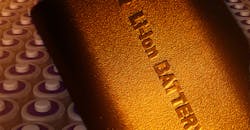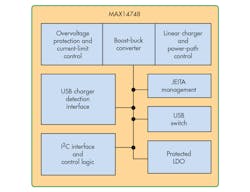Charge 2-Series Li-Ion Battery Packs with Single-Chip USB Type-C Device
A variety of applications take advantage of the simplicity of USB Type-C connectors for charging and transferring multimedia data. These range from wireless speakers to cameras, handheld barcode readers, virtual-reality (VR) headsets, and portable medical devices. Power demands for these applications are often met with 2-series battery packs; however, these packs also require ample energy to recharge. Generally speaking, developing USB Type-C products powered by 2-series battery packs typically needed multiple discrete components.
But that may no longer be the case. Maxim Integrated developed a 15-W single-chip solution, designated MAX14748, which integrates USB Type-C charger detection, a boost/buck converter, and a Li-ion battery charger. Minimizing the need for discrete components reduces the power-management footprint as well as bill-of-materials (BoM) cost. What’s more, it eliminates additional points of potential failure within the circuit.
The MAX14748 permits USB Type-C charging from legacy 5-V USB adapters at twice the power of Micro USB solutions. It features programmable automatic input-current limiting (AICL) to ensure that maximum safe current is drawn from the charging adapter, protecting end equipment.
The MAX14748 integrates a charger detector, boost/buck converter, and a Li-ion battery charger.
An automatic Smart Power Selector chooses between the internal battery and an external USB port adapter for any application it runs. It can simultaneously charge the battery and provide power to the system load (adapter power not used by the system is channeled toward charging the battery). The Smart Power Selector function will supplement the system power with the battery if power from the charging adapter is insufficient.
The charging controller automatically detects adapter types. It accepts input currents up to 1,500 mA and outputs charging currents up to 900 mA. Shutdown current (preserving battery life) is just 6 µA. The integrated boost/buck converter operates at 92% in boost mode at 1-A output current and 7.4-V battery voltage, and 94% in reverse buck mode at 500-mA output.
The Li-ion charger offers Japan Electronics and Information Technology Industries Association (JEITA) thermal monitoring. To provide some context on this feature, lithium batteries can become dangerous when they’re overcharged at high temperatures. The JEITA standard defines the charging envelope for these batteries, stressing the need to avoid high charge currents and high charge voltages outside of a particular temperature range. Thermal runaway resulting in battery fires could occur when the internal temperature of a lithium battery reaches approximately 175°C, so temperature monitoring is critical.
The JEITA guidelines state that for temperatures between 45 and 50°C the regulation voltage should be reduced from 4.25 to 4.15 Vmax and for battery temperatures between 50-60°C it should be 4.1 Vmax. Over 60°C, there should be no charging.
In addition to JEITA charge protection, other protection features designed into the MAX14748 include 28-V integrated overvoltage protection and ±15-kV ESD protection on USB adapter pins.
The MAX14748 offers support for devices functioning as a UFP/DRP per the USB Type-C 1.1 standard, while also providing detection of legacy USB Battery Charging Specification, Rev.1.2 (BC1.2) compliant chargers. UFP is the Upstream Facing Port, while the Dual-Role Port (DRP) is a port that transitions between DFP and UFP until the occurrence of an attach event.
The device comes in a 54-bump, 0.4-mm pitch, 3.97- × 2.77- × 0.64-mm wafer-level package (WLP) and operates over the −40 to +85°C extended temperature range. An evaluation kit comprising a fully assembled and tested circuit for the MAX14748 USB Type-C charger also is available. The EV kit allows for access to the I2C interface of the MAX14748 through the J5 PMOD connector.


